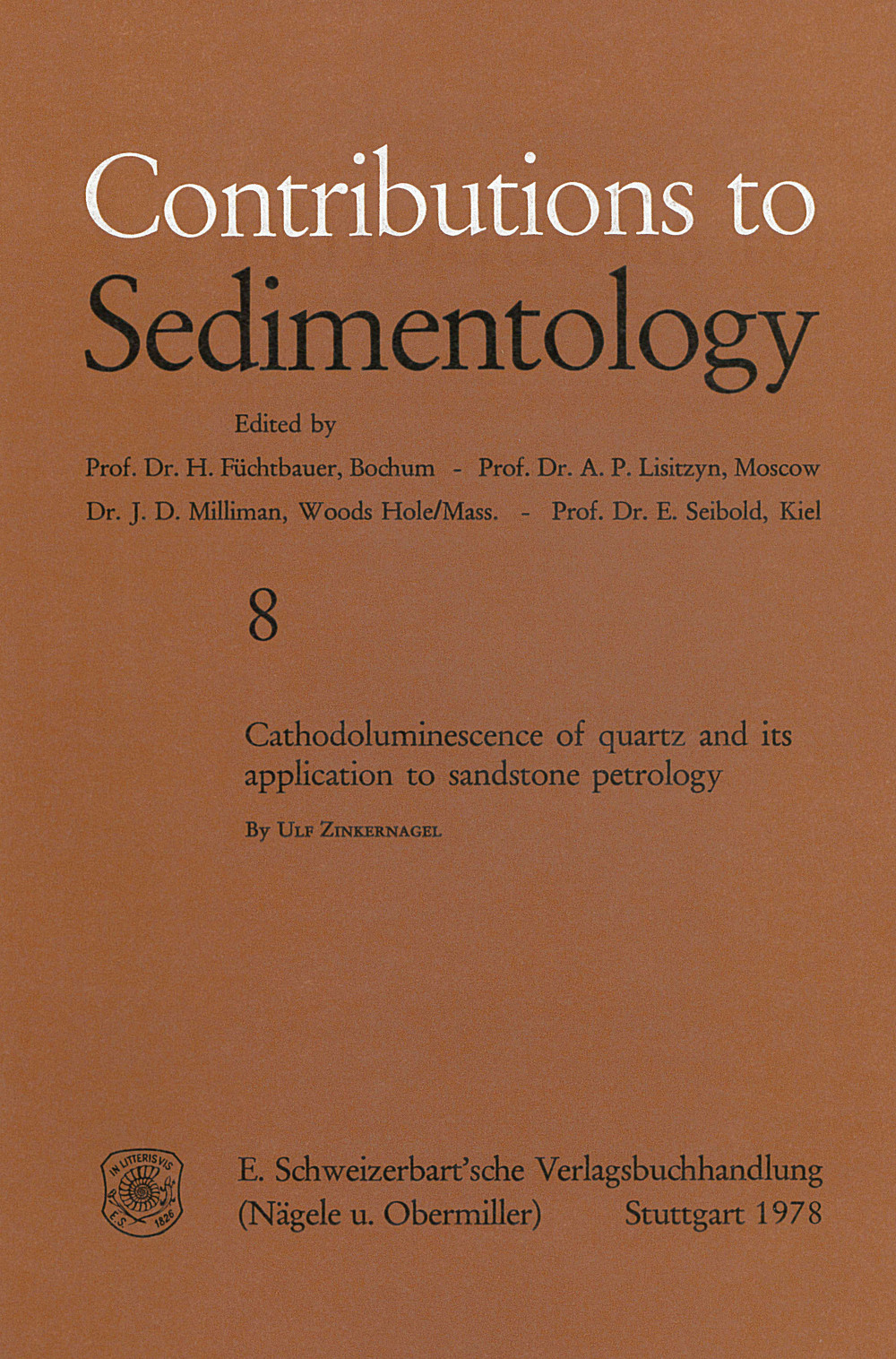Ulf Zinkernagel:
Cathodoluminescence of quartz and its application to sandstone petrology
1978. IV, 69 pages, 14 figures, 5 tables, 16x24cm, 280 g
Sprache: English
(Contributions to Sedimentary Geology, Volume 8)
ISBN 978-3-510-57008-9, paperback, Preis: 28.00 €
Auf Lager und sofort verfügbar
BibTeX Datei
quartz •
sandstone •
petrology •
sediment •
geology •
luminescence •
Quartz •
Sandstein •
Petrologie •
Sediment •
Geologie •
Lumineszenz
Cathodoluminescence investigations of quartz-bearing rocks lead to the definition of three luminescence types of quartz: "violet", brown, and non-luminescing quartz, whose occurrence is characteristic for rocks of distinct temperature history: "violet" luminescing quartz in igneous rocks, brown luminescing quartz in regional metamorphic rocks, non-luminescing quartz formed diagentically in sediments. This is demonstrated by several geological case histories, e.g. contact metamorphic rocks of the Wiborg-Rapakivi-Massif, Finland, weakly metamorphized or tempered sandstones with diagenetic quartz. Differences in the luminescence of diagenetic and detritial quartz make possible to count them separately. Apparantly, quartz cementation is the most important diagenetic fabric in sandstones, while the influence of pressure solution at quartz-quartz contacts is less determinant. Chemical dissolution processes of quartz are mostly younger than quartz cementation.
Kathodenlumineszenz-Untersuchungen an quarzführenden Gesteinen führten zur Unterscheidung von drei Lumineszenztypen für das Mineral Quarz ("violett", braun und nicht leuchtender Quarz), deren Auftreten an die Temoperaturgeschichte der Gesteine gebunden ist ("violett" leuchtender Quarz in magmatischen Gesteinen, braun leuchtender Quarz in Regionalmetamorphiten, nicht leuchtender Quarz als diagenetische Bildung in Sedimenten). An einigen geologischen Fallstudien (Kontaktgesteine des Wiborg-Rapakivi Massivs (Finnland); schwach metamorphe oder getemperte Sandsteine mit diagenetischem Quarz) wird der Temperatureinfluß auf die Quarzlumineszenz demonstriert. Das unterschiedliche Lumineszenzverhalten von diagenetischen und detritischem Quarz ermöglicht die getrennte quantitative Erfassung von beiden. Die Untersuchung des Probenkollektivs ergibt, daß die Quarzzementation das bestimmende Element für diagenetische Gefüge in Sandsteinen ist, während der Einfluß von Drucklösung an Quarz-Quarz Kontakten nur sehr gering ist. Chemische An- oder Auflösung von Quarz ist meist jünger als die Quarzzementation.
Description du Contenu
nach oben ↑
Des recherches de la luminescence cathodique des roches contenant du quartz aboutissent à une différenciation de trois types de luminescence pour le mineral quartz ("violet", marron et non-lumineux) dont la présence est liée à la l'histoire de la température des roches (le quartz "violet" brillant dans des roches magmatiques, le quartz marron brillant dans des roches métamorphiques régionales, le quartz non-lumineux comme formation diagénétique dans des roches sédimentaires). L'influence de la température sur la luminescence du quartz est démontrée par quelques cas géologiques (roches de contact du Massif du Rapakivi (Finlande), roches peu métamorphiques ou bien des grès peu trempés avec du quartz diagénétique. Le comportement luminescent du quartz diagénétique et détritique donne la possibilité de recenser la quantité des deux séparément. De l'examen de l'ensemble des échantillons résulte que la cimentation du quartz est l'élément diagénétique primordial de grès, tandis que l'influence de la dissolution sous pression aux contacts quartz-quartz est très minime. La dissolution chimique du quartz est dans la plupart des cas plus rècente que la cimentation du quartz.
Abstract, Zusammenfassung, Résumé 1
Introduction 2
1. Method 3
1.1 The term “luminescence” 3
1.2 Development of the method 3
1.3 Physical interpretation ofluminescence 4
1.4 Cathodoluminescence device 7
1.5 Preparation ofthin sections 8
1.6 Photographic reproduction 9
2. Luminescence of quartz
2.1 General observations 9
2.2 Rocks with “violet” luminescing quartz 10
2.21 Igneous rocks 10
2.22 Contact metamorphic rocks 11
2.3 Rocks with brown luminescing quartz 12
2.31 Metasediments 12
2.32 Metamorphized igneous rocks 13
2.33 Weakly tempered, quartz-cemented orthoquartzites 14
2.4 Rocks with quartz luminescing in the transition from “violet” to brown 14
2.5 Rocks with non—luminescing quartz 15
2.6 Luminescence of quartz formed unter hydrothermal conditions 15
3. Qualitative luminescence studies of synthetic quartz cultured under
hydrothermal conditions 16
3.1 Experimental conditions 16
3.2 Luminescence ofthe nuclei 16
3.3 Luminescence ofsynthetic quartz 16
4. Wave-length characteristics of the visible light emitted by natural
quartz 18
4.1 Basic observations 18
4.2 Influence of the time of excitation by cathode ray 19
4.3 Luminescence changes by thermal treatment i 22
4.31 “Violet” luminescing quartz 22
4.32 Non—luminescing quartz 23
5. Discussion 24
5.1 General remarks 24
5.2 “Activator luminescence” versus “lattice luminescence” 24
5.3 Luminescence in relation to lattice order 26
5.4 Energy levels oflattice imperfections related to temperature 27
5.5 Lattice imperfections possibly not due to temperature influences 28
6. Sandstone petrology 29
6.1 Petrological investigations of Carboniferous and Devonian'sandstones
from the exploration well Mijnsterland 1 (NW-Germany) 29
6.11 Methods 30
6.12 Petrography ofthe sandstones 30
6.13 Luminescence ofsand-size quartz detritus 32
6.14 Luminescence ofquartzitic rocks fragments 33
6.15 Quartz balance of the sandstones 34
6.16 Quartz diagenesis 36
7. Discussion 38
7.1 Pressure solution 3. str 38
7.2 Quartz dissolution 40
7.3 Quartz cementation 40
7.4 Silica sources 41
7.5 Stylolithic dissolution planes in sandstones 42
7.6 Conclusions 43
Acknowledgements 43
8. List of specimen 49
9. References 54
10. Appendix: Luminescence instrument 59
Arrangement 59
Specimen chamber 59
Radiation switch 62
Electron gun 63
Electrical supply 64
Vacuum making 66
Transmittent light source 66
